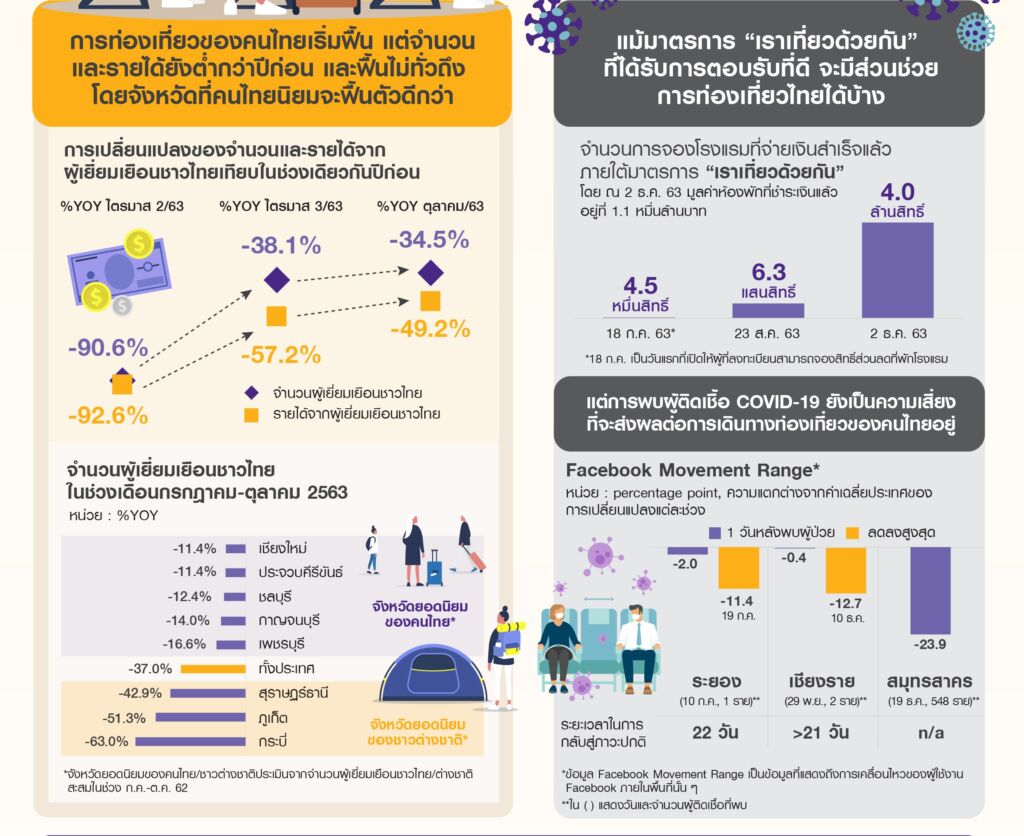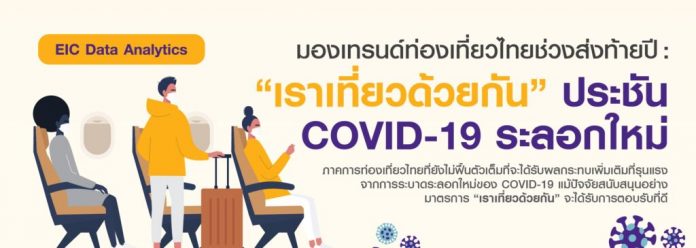
EIC Analyzed that the Thai tourism sector has not fully recovered will suffer further severe effects from the new outbreak of COVID-19 Although supporting factors such as measures “We travel together” has been well received in the past.
In the past, the Thai tourism sector has gradually recovered from the tourism of Thai people. But both the number and income remained lower than the previous year. While the recovery in the past was not thorough. By provinces that Thai people are already popular to travel In the past, it was a better recovery group.
The Thai tourism sector, which this year, which has deteriorated from the disappearance of foreign tourists, has begun to break past the lowest point during the lockdown period. After Thais began to travel in the country more and more. However, domestic tourism With Thai people still returning not the same as the same period in the previous year Recently, the number of Thai tourists during the month of October Still lower than -34.5% YOY in the same period last year (a decrease from -38.1% YOY in the third quarter).
While income from Thai tourists is lower than -49.2% YOY (a decrease from -57.2% YOY in the third quarter). A contraction than the number of tourists means In addition to Thai people traveling less then Also decreased average spending per person as well It is a stumbling block of tourism expansion by Thai people over the past five years (2015-2019), according to the National Statistical Office’s Socio-Economic Survey data. Thai households spend on tourism increase an average of 3.9% per year, although overall spending slows down -0.5% per year.
However, despite the start of foreign tourists arriving in October But it is still a very small number of only 1,201, or about 04% of the total number of foreign tourists in the same month last year.

In this sluggish state The presence of supporting factors from the measures “We Travel Together” is considered to help the tourism sector in the country as of December 2, 2020, the number of people who have registered for the measure has already been 4 million and has been used to book accommodation Paid 4 million rights from 5 million rights, totaling 10,961 million baht of rooms booked.
however RecoveryOf domestic tourism looks not thorough The provinces that have recovered better than average are often the most popular provinces of Thai people. On average during July – October (Latest data) Average number of Thai visitors contracted at -37.0% YOY from the same period last year. While the province is popular (Estimated from the accumulated number of Thai visitors during July – October 2019), such as Chiang Mai, shrinking only -11.4% YOY as Prachuap Khiri Khan (-11.4% YOY), Chonburi (-12.4% YOY), Kanchanaburi (-14.0% YOY) and Phetchaburi (-16.6% YOY).
While provinces in the south that used to be popular with foreign tourists (Estimated from the number of foreign visitors accumulated during Jul – Oct ’19) Recover more slowly For example, Phuket, where the total number of Thai visitors during July – October decreased from the same period last year to -51.3% YOY, as well as Surat Thani (-42.9% YOY) and Krabi (-63.0% YOY). The decrease of Thai people visiting these provinces may come from a combination of factors.
And the cost of the trip is higher Which reflects the changing behavior of Thai people according to the economic slowdown Long distance travel from other regions is in line with Suan Dusit University survey which found that Thais prefer to travel closer to their home. In addition, there was an impact from storms that resulted in flash floods in many areas in the south from October to December.
In the beginning of the fourth quarter, the direction of recovery in tourism provinces far from Bangkok Began to improve After tourists Began to gain more confidence in flying Causing the tourist provinces far away from Bangkok (Travel distance by car more than 4 hours from Bangkok) such as Chiang Mai and Mae Hong Son began to adjust in a better direction. Unlike in the post-lockdown period in the third quarter, domestic tourism will begin to recover in the provinces close to Bangkok first. Which improved, it is still a popular tourist province in Thailand before

Concerns over the spread of COVID-19 It is a factor that rapidly affects the tourism of Thai people. After Thailand was able to control the spread of COVID-19 until the number of new infections decreased and most of them came from abroad and in State Quarantine, but when Thailand had an incident with COVID-19 infection that Affected to travel activities, including tourism in the area together with two previous events, namely the incident in Rayong Province on July 10 and Chiang Rai Province on December 2. The travel activity in both the said provinces immediately declined.
From travel data of Facebook (Facebook Movement Range) for events in Rayong It takes about 22 days to get back to normal. While Chiang Rai events have a significant drop in travel traffic compared to the national average and have a negative impact on Chiang Rai tourism during the winter, which is the high season of each year. Effects are relatively limited in endemic areas. In the case of Rayong Province
Facebook’s travel data in nearby provinces like Chonburi and Chachoengsao did not slow down in Rayong. This is similar to the case in Chiang Rai, where Google Trends and Facebook’s travel data in neighboring provinces like Chiang Mai are likely to slow down, but not as much as Chiang Rai and do not slow down. He fell as soon as he found an infected person in Chiang Rai. This may be due to the not-so-high number of cases and the sites where the infected people were found are not the center of inter-provincial traffic. COVID-19 has a significant impact on the tourism sector.
The epidemic of COVID-19 The new wave is likely to have a serious backlash on tourism. For events The latest outbreak in Samut Sakhon province since December 19, which saw 1,356 cumulative cases (as of Dec. 24), Facebook travel data also dropped immediately, one day after the outbreak. Samut Sakhon’s Facebook travel data is down 23.9 percentage point higher than the national average.
Which is higher than the case of Rayong (Decrease than the national average of 2.0 percentage point) and Chiang Rai (decrease than the national average of 0.4 percentage point)
And this outbreak may be more severe and affect nearby provinces than those in Rayong and Chiang Rai because
- There is a high number of infected cases detected. Making it difficult to track and control
- Is involved in a food wholesale market As a result, the COVID-19 outbreak has spread widely in many provinces.
- May affect the manufacturing sector other than the tourism sector, such as the food production sector. Construction sector Therefore, this new wave of COVID-19 is more violent than the previous two events.
Concerns over the spread of COVID-19 As a result, Thai people tend to change tourism behavior at the end of the year. The results of the public opinion poll of 1,277 people across the country between 4-10 December 2020 titled “Thai People and the End of Tourism 2020” by Suan Dusit University found that the most change in tourism behavior of Thai people in 2020 was: Travel carefully Not going to travel in crowded places Choose more attractions
Tourism in places close to home In addition, the survey also found that the COVID-19 epidemic will remain the situation that will affect Thai New Year travel planning the most. The example that is obvious is An event of concern over the epidemic in Chiang Rai that may continue to affect decisions to travel during the final turn of the year.In the said province
This was reflected in the drop in Google search-related search terms for accommodations in Chiang Rai after finding infected people outside State Quarantine on November 29 and people with domestic infections on December 2, with the Google Trends index falling to the lowest. During December 13-19, at -46.9% compared to the average during 2017-2019.
While the events in Samut Sakhon had a direct impact on tourism at the end of the year. As lockdowns began in many provinces where infected cases were detected and public sector confidence in disease control began to decline. In addition, shopping malls and private sectors in the prevalent provinces began announcing the suspension of activities at the end of the year. In addition, the discovery of infected people spreading in many provinces may cause some residents to decide to postpone their trips. The end of the year was due to concerns over the spread of various locations and a lack of confidence in air travel and ground public transportation.
The EIC views that the Thai tourism business in 2021 has many challenges. Which consists of the following factors
- Risk of epidemic COVID-19: It is a challenge that will persist until immunization occurs.
Broadly, the EIC estimates that developed countries will receive a broad-spectrum vaccine and go into herd immunity in the first half of 2021, while Thailand is likely to start in the middle of next year. And will enter the state of group protection
Yes, within the first half of 2022, the issue of getting this vaccine will also affect foreign tourists’ arrival to Thailand and the decision to open our home country as well. Therefore, all sectors should still have to take a high level of caution in order for the tourism sector to recover as expected. The EIC predicts that the number of foreign tourists in 2021
It is approximately 8.5 million people, most of which will begin to travel in the second half.
EIC Looking at that although it will take some time for Thailand to receive the vaccine But the government and tourism operators should be prepared for accepting foreign tourists early. Whether it is planning to allocate a vaccine thoroughly to personnel in the tourism sector. Public relations to invite and build confidence Including setting up a system to verify information Hygiene and vaccination information that may be needed in recent travel.
- Sluggish tourist purchasing power : It is a factor caused by the impact of the economy in the past. Therefore, stimulus measures from the government will be a key driver in stabilizing tourism spending for a long time.
Extension of the project duration “We travel together”, or the launch of a new tourism promotion campaign, will play an important role in tourism early next year. Under the assumption that Thailand will be able to control this new outbreak. - Change in tourist behavior : Such as increased caution about hygiene Avoiding crowded places Looking for an incentive promotion Worth the price in a condition that purchasing power is limited
- The competition between the tourism business is more intense. : Both in terms of sales and promotion
The incentives that are likely to continue in the face of lower occupancy demand due to the disappearance of foreign tourists. While the supply of the room is the same Until it starts to support the demand for accommodation from foreign tourists.
Source: Siam Commercial Bank (Public Company Limited)



